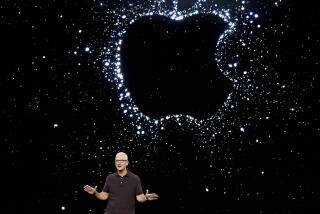INNOVATION / MICHAEL SCHRAGE : Culture Clashes May Ruin Apple-IBM Deal
It would be bizarre--if not tasteless--for a couple that had just negotiated a prenuptial agreement to start boasting about which college their future child was headed for. But that’s precisely the sort of weird expectations surrounding the proposed IBM-Apple Computer partnership--a high-tech matchup that moved one palpitating analyst to foam that this was the deal of the decade.
More likely, Apple-IBM is the deal of the decade in much the same way that the Madonna and Sean Penn nuptials were the marriage of the decade: big names, lotsa personality but not necessarily a relationship destined to change the world.
IBM’s multibillion-dollar acquisition of Rolm was supposed to transform the global telecommunications landscape. General Motors’ acquisition of Ross Perot’s EDS and Hughes Aircraft was going to give the world’s largest company new profitability with high-tech-enriched automobiles. It wasn’t to be.
The only thing more difficult than managing the challenge of a high-technology breakthrough is managing the challenge of a high-technology relationship. The people at IBM and Apple know this.
On the other hand, corporate capacity for self-deception is enormous. The notion of Apple and IBM snuggling up together in digital bliss is so audacious, ironic and compelling that even the blandest of blue-suited MBAs could be excused for finding it irresistible. (As Machiavelli, the leading management consultant of the Renaissance once noted, “Make no small plans . . . for they have not the power to stir men’s blood.”) The proposed alliance even hews to the Washington admonition “Keep your enemies in front of you.”
But does it really make sense? Will it generate dollars? Even by computerdom’s brutal standards, an Apple-IBM alliance is breathtakingly ruthless. It begs the cynical question: What won’t IBM or Apple do to instill fear, uncertainty and doubt into their competitors?
If IBM had slipped a horse’s head onto Bill Gates’ pillow, it couldn’t have sent a clearer signal to the young billionaire that Big Blue was unhappy with Microsoft.
The IBM PC clonesters, Sun Microsystems, newlyweds AT&T; and NCR plus the acquisitive Japanese are all now forced to recalibrate their strategic aspirations: “Just how serious is this alliance, anyway?
Can we afford to compete head-to-head against IBM and Apple? Who should our allies now be?”
More important, the alliance is as much a medium to absorb Apple’s and IBM’s growing technical and market risk as it is a vehicle to mess up the competition. In truth, the underlying motive for the alliance is defensive. Apple desperately wants to increase market share. Even after slashing prices, its computers aren’t breaching the walls of corporate America in the volumes necessary to sustain the company’s desired growth and profitability. What’s more, the challenge of designing machines that can readily link into companywide networks is both daunting and expensive.
IBM, on the other hand, sees the value of its personal computers being shaped more by companies like Microsoft and Intel than by its own technologies. What’s more, it senses that computers and workstations designed by companies like Apple and Sun Microsystems--not to mention the software that animates them--represent the future of the industry. Co-designing technology with Apple preserves IBM’s enormous marketing clout even as it theoretically enables the computer giant to weave new value into its own machines.
Technological opportunism is thus transformed into grand strategy. Unfortunately, grand strategies tend to be assassinated by small details.
The idea that Apple and IBM will collaborate to bring a new generation of object-oriented software (software that will be ridiculously easy to transport from computer to computer, fairly easy to modify and maintain and rich in functionality) is terrific. The catch is, Apple and IBM have yet to work out the details.
“The object-based systems stuff is probably the most important,” says David Nagel, Apple vice president of advanced technology. “But a lot of things are still in the discussion phase.”
For example, it’s unclear whether the joint venture would have Appleniks and IBMers “co-located,” says Nagel--or even how many people each company would contribute. Nevertheless, Nagel sees the software venture as providing “a vehicle for smart people on both sides to do things they wouldn’t be able to do otherwise.”
The problem isn’t that Apple and IBM don’t have gobs of smart people, it’s that the structures and market imperatives of their organizations get in the way of their making the fundamental technical changes that are necessary. Organizational culture wields a greater influence over the development of technology than any technology does over the culture of the organization.
Does anyone in Cupertino or Armonk really think that a joint venture of Apple and IBM will be able to wield more influence over systems software development than the parent companies? Apple has “software evangelists” who preach Apple gospel and bring back developer insights for Apple’s systems designers.
IBM has a less flamboyant approach. Does anybody really believe that Apple and IBM hold comparable technology-design philosophies that will seamlessly blend into artifacts and algorithms that redefine personal computing? As provocative as an Apple/IBM alliance is, the reality is that these companies have fundamentally different views of both their markets and technologies.
Consequently, the only way this alliance can succeed is if both companies decide that the goals of the alliance are more important than the goals of the individual companies themselves. I don’t think John Akers or John Sculley will be able to justify that to their respective shareholders. Good luck to them.
A SKEPTICAL VIEW
Lawrence J. Magid looks at the IBM, Apple alliance. D3
More to Read
Inside the business of entertainment
The Wide Shot brings you news, analysis and insights on everything from streaming wars to production — and what it all means for the future.
You may occasionally receive promotional content from the Los Angeles Times.










